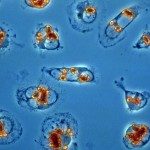Link to Pubmed [PMID] – 21501362
Cell. Microbiol. 2011 Jul;13(7):978-91
Protozoan parasites of the genus Leishmania are important human pathogens that differentiate inside host macrophages into an amastigote life cycle stage. Although this stage causes the pathogenesis of leishmaniasis, only few proteins have been implicated in amastigote intracellular survival. Here we compare morphology, infectivity and protein expression of L. donovani LD1S grown in host free (axenic) culture, or exclusively propagated in infected hamsters, with the aim to reveal parasite traits absent in axenic but selected for in hamster-derived amastigotes through leishmanicidal host activities. Axenic and splenic amastigotes showed a striking difference in virulence and the ability to cause experimental hepato-splenomegaly in infected hamsters. 2D-DIGE analysis revealed statistically significant differences in abundance for 152 spots, with 14 spots showing fivefold or higher abundance in splenic amastigotes. Proteins identified by MS analysis include the anti-oxidant enzyme tryparedoxin peroxidase, and enzymes implicated in protein and amino acid metabolism. Analysis of parasite growth in vitro in minimal medium demonstrated increased survival of hamster-derived compared with axenic parasites under conditions that mimic the nutrient poor, cytotoxic phagolysosome. Thus, our comparative proteomics analysis sheds important new light on the biochemistry of bona fide amastigotes and informs on survival factors relevant for intracellular L. donovani infection.





